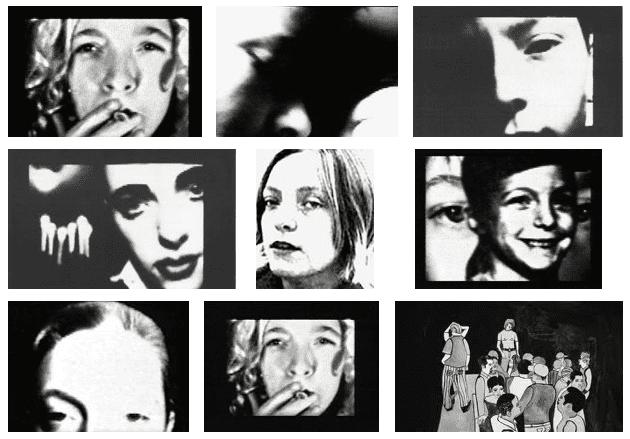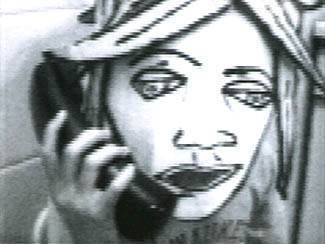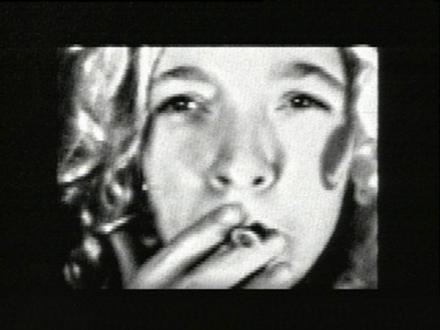Origin American Parents James Benning Role Artist | Name Sadie Benning | |
 | ||
Born April 11, 1973 (age 52) ( 1973-04-11 ) Artwork Wipe, Montana Gold Banana and Ace Fluorescent Green Movies Flat is Beautiful, It wasn't Love, Girl Power Albums Le Tigre, Feminist Sweepstakes, From the Desk of Mr Lady Similar People | ||
Music group Le Tigre (1998 – 2001) | ||
Sadie benning art 199
Sadie Benning (born April 11, 1973) in Milwaukee, Wisconsin, US is an American video and visual artist. A 2005 Guggenheim Fellow, Benning has repeated throughout the body of their work the themes of masculinity vs. femininity and the challenges of being young.
Contents
- Sadie benning art 199
- Sadie benning
- Early life
- Early works
- Early themes
- Le Tigre
- Exhibitions
- Awards recognitions and honors
- Works
- References

Sadie benning
Early life

Benning was raised by her mother in inner-city Milwaukee, Wisconsin. She left school at age 16, primarily due to the homophobia she experienced. She started filming with the "toy" video camera she received from her father, a film making teacher.
Early works
Benning began creating visual works at age 15. She used a Fisher-Price Pixelvision camera, the Fisher-Price PXL-2000 which was a Christmas gift from her father, the experimental filmmaker James Benning.
At first, she was standoffish to the PixelVision camera which recorded pixelated, black and white video images onto standard audio cassettes. Benning is quoted as saying, "I thought, 'This is a piece of shit. It's black-and-white. It's for kids. He'd told me I was getting this surprise. I was expecting a camcorder." Her first mysterious video was in a film festival when still a teenager.
Early themes
The majority of Benning's shorts combined performance, experimental narrative, handwriting, and cut-up music to explore, among other subjects, gender and sexuality. Her work has been included in the Whitney Biennial on three occasions.
Benning's earlier videos – A New Year[1], Living Inside, Me and Rubyfruit, Jollies, and If Every Girl Had a Diary - used Benning's isolated surroundings and the effect this had on Benning as the main focus. In Benning's earliest work, A New Year, Benning shied away from being in front of the camera, using her surroundings – primarily the confines of their room and their bedroom window – to portray their feelings of angst, confusion and alienation. "I don't talk, I'm not physically in it, it's all handwritten text, music; I wanted to substitute objects, things that were around me, to illustrate the events. I used objects in the closest proximity – the television, toys, my dog, whatever."
The themes of sexual identity and the challenges of growing up are repeated throughout the body of Benning's work. Benning uses pop culture, such as music, television or newspapers, to amplify their message while simultaneously parodying the same pop culture. Benning also draws inspiration from images on television or in movies. "They're totally fake and constructed to entertain and oppress at the same time – they're meaningless to women, and not just to gay women. I got started partly because I needed different images and I never wanted to wait for someone to do it for me". Given her confinement, the use of these mediums in her work is practical and gives insight to the viewer of how Benning has been mostly interacting with the world.
As her work has progressed, Benning has increasingly used images of her own body and her voice. In works such as If Every Girl Had a Diary, Benning uses the limitations of the PixelVision to get extreme closeups of her own face, eyes, fingers, and other extremities so that the focus is on sections of her face as she narrates her life and thoughts. "Benning's daring autoerotic and autobiographic videos, her ability to make the camera seem a part of her self, and extension of her body, invite the audience to know her."
Le Tigre
In 1998, Benning co-founded Le Tigre, the feminist post-punk band whose members include ex-Bikini Kill singer/guitarist Kathleen Hanna and zinester Johanna Fateman. Benning left the band in 2000. JD Samson joined Le Tigre after Benning's departure.
Exhibitions
In 2006, in collaboration with Solveig Nelson, Benning created Play Pause – a two-screen projected video installation. It was debuted at the Wexner in 2007 as part of the exhibition, "Sadie Benning: Suspended Animation." In September 2007, "Play Pause" was exhibited at the Dia Center in NYC. Concurrent with the Dia installation, the collaboratively run Orchard Gallery exhibited her abstract drawings, video installation, wall sculptures, and "play/pause" records in the solo show, "Form of...a waterfall." Two works from this exhibition were included in the 2007 White Columns Annual. Recent exhibitions include Play Pause, Power Plant Gallery (2008), 7th Gwangju Biennale (2008), and VHS the Exhibition, Franklin Street Works (2012).
In 2013, Benning was commissioned by the Carnegie Museum of Art for an instillation of abstract paintings entitled Locating Center.
Awards, recognitions and honors
In 1991, the first article about Benning's work, written by Ellen Spiro, appeared in the national gay magazine The Advocate.
In 2004, Bill Horrigan curated a retrospective of Benning's works on video.
Benning has received grants and fellowships from Guggenheim Foundation, Andrea Frank Foundation, National Endowment of the Arts, and Rockefeller Foundation. Awards include Wexner Center Residency Award in Media Arts, National Alliance for Media Arts & Culture Merit Award, Grande video Kunst Award, and the Los Angeles Film Critics Circle Award.
She received her M.F.A. from Bard College. Her videos are distributed by Video Data Bank.
Works
Benning's Susanne Vielmetter Los Angeles Projects biography contains an exhaustive list of works.
